In 2011, 7.7 million children were living in the same household as at least one of their grandparents.4 This translates into 10% of all children under the age of 18 in the U.S. A sizable minority of these children are not only living with their grandparent, but are being cared for by their grandparent as well. All told, 4% of minors—more than 3 million children—fall into this category.
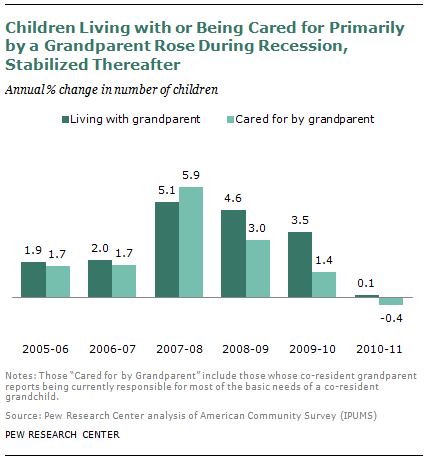
The number of children living with or being cared for primarily by grandparents rose gradually from 2000, when data were first collected, and then began a more precipitous rise after the onset of the recession in 2007. The number of children with co-resident grandparents rose by 5 percent from 2007 to 2008, and the number of children being cared for primarily by a grandparent rose by almost 6 percent during that same period.
The increases have been more modest since 2008, however, and from 2010 to 2011 both the number of children living with a grandparent and the number being cared for by a grandparent remained virtually unchanged.5
The Likelihood of Living with or Being Cared for by a Grandparent
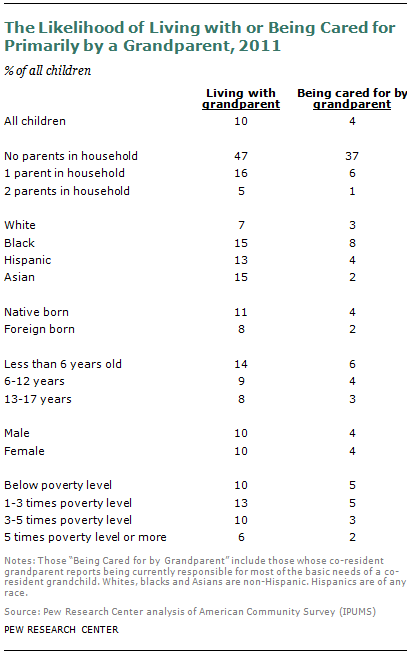
Children who are living apart from their parents are among the most likely to be living with a grandparent; fully 47% do. In contrast, children living with one or both parents are much less likely to be living with a grandparent. Some 16% of children living with one parent are also living with a grandparent, and 5% of children who live with both parents live with a grandparent.
Similarly, children who are living apart from their parents are also most likely to have a grandparent caregiver; more than one-third (37%) do. Among children living with one parent, 6% have a grandparent caregiver. Just 1% of children living with two parents have a grandparent caregiver.
Black and Asian children are more likely than Hispanic or white children to be living with a grandparent. Some 15% of both blacks and Asians are doing so. For Latinos, the share is 13%, and just 7% of white children are living with a grandparent.
Black children are at least twice as likely as children of other racial and ethnic groups to be under the care of a grandparent. Some 8% of black children fall into this category. Among Latino children, the share is 4%. Some 3% of white children are cared for primarily by a grandparent. While a relatively large share of Asian children live with their grandparents, only 2% are being cared for primarily by those grandparents.
Native-born children are more likely to be living with a grandparent than are foreign-born children, and are more likely to be cared for primarily by a grandparent, as well. Some 11% of native-born children, compared with 8% of those who are foreign-born, are living with a grandparent. And 4% of native-born children are cared for primarily by a grandparent, compared with 2% of foreign-born children.6
This may seem counterintuitive, given that immigrant families are more apt to live in multigenerational households. However, it is likely that if a child was born outside of the U.S., the grandparent may still be residing outside of the U.S. and thus be unavailable for co-residence or caregiving.
Younger children are particularly likely to be living with a grandparent—fully 14% of those under the age of 6 are. In comparison, 9% of children ages 6 to 12 and 8% of those ages 13 to 17 live with a grandparent. A similar pattern emerges in terms of receiving care from a grandparent. A grandparent is the primary caregiver for 6% of those under age 6. In comparison, 4% of children ages 6 to 12 are cared for primarily by a grandparent, as are 3% of those ages 13 to 17.
Children living in or near poverty are more likely to be living with a grandparent, or cared for primarily by a grandparent, than are children who are more economically advantaged. Some 10% of children living below the poverty line are living with a grandparent, while just 6% of those in households with incomes at least five times above the poverty line are. And while 5% of those whose household incomes are three times the poverty level or less are being cared for by a grandparent, the number drops to 2% for those living in households with incomes at least five times above the poverty line.7
The Likelihood of Living with, or Being Cared for by, a Grandparent, by Race and Ethnicity
While the likelihood that a child will either live with a grandparent or be cared for primarily by a grandparent varies considerably by race and ethnicity, the demographic patterns relating to grandchild co-residence and care are fairly consistent across racial and ethnic groups. For instance, among blacks, whites, Hispanics and Asians, younger children are more likely than older children to be either living with, cared for primarily by, a grandparent. And for all groups, the native born are markedly more likely than the foreign born to live with a grandparent, or be cared for primarily by a grandparent.
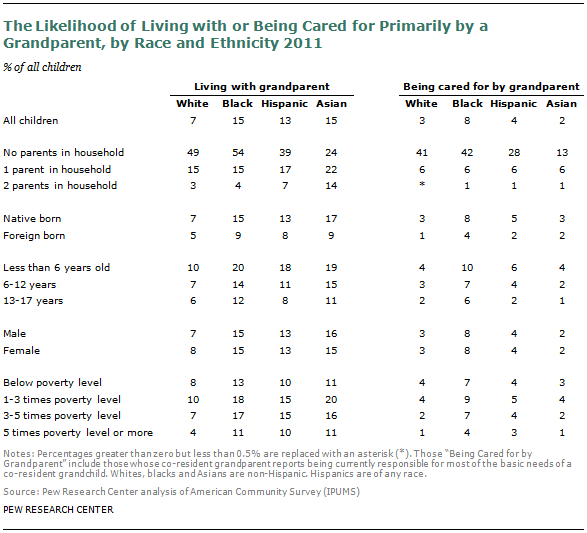
The one characteristic where notable racial and ethnic differences emerge is household structure. White and black children look fairly similar—about half of those who have no parent in the household are living with a grandparent, as are roughly 15% of those who also have one parent in the household and 3% of those with two parents present. Among Hispanic children living apart from their parents, only 39% are living with a grandparent. Some 17% of those living with one parent live with a grandparent, and 7% of those who have two parents in the household also live with a grandparent.
While in most cases the likelihood of living with a grandparent declines precipitously with the presence of one or two parents in the household, among Asian children this pattern is less salient. Just 24% of Asian children who live apart from their parents are living with a grandparent. However, compared with the other groups, a larger share—22%—of Asian children who live with one parent are also living with a grandparent, and fully 14% of those living with two parents are living with a grandparent.
For children in all four racial and ethnic groups, the likelihood of being cared for primarily by a grandparent is similar for those living with either one parent or two parents. About 6% of those with one parent are being cared for primarily by a grandparent, as are 1% of those living with two parents. Differences persist, though, among those children living apart from their parents. While just over 40% of white children and black children in this category are being cared for primarily by their grandparents, this share drops to 28% for Hispanic children and to only 13% for Asian children.
Profiles of Children who Are Living with or Being Cared for Primarily by Grandparents
Another way to look at children living with or being cared for primarily by grandparents is to consider the makeup of those who are in these situations. The profile, or composition, of these children is a function of the general makeup of all children in the U.S. and the fact that different subgroups are more or less likely to be living with or cared for by a grandparent. For instance, white children are less likely than other groups to be living with a grandparent. As a result, the total composition of white children living with a grandparent is 38%—far lower than their share in the overall population of children (53%).
In 80% of cases where a child is living with a grandparent, there is also at least one parent living in the household as well. For half (51%) of these children, there is one parent in the household, and for 29%, there are two parents in the household, in addition to a grandparent. One-fifth of children living with a grandparent are living apart from their parents.
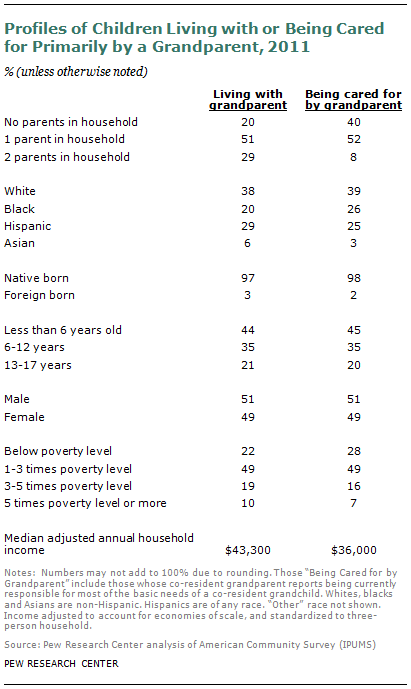
Among those children being cared for primarily by a grandparent, 52% are living with one parent, and 8% are living with both parents. The remaining 40% of children being cared for by a grandparent are living apart from their parents. In comparison, among all children in the U.S., 62% are living with two parents, 34% are living with one parent, and 4% are living apart from both parents.
Fully 38% of children living with a grandparent are white, and 29% are Hispanic. One-fifth (20%) are black, and 6% are Asian. The pattern is similar among the subset of children who are also being cared for primarily by a grandparent—39% are white, 26% are black, 25% are Hispanic and 3% are Asian. In contrast, among all children in the U.S., just over half (53%) are white, 24% are Hispanic, 14% are black and 4% are Asian.
A plurality of children living with grandparents—44%—are under the age of 6. However, notable shares are ages 6 to 12 (35%) and 13 to 17 (21%). Among those children being cared for primarily by grandparents, 45% are under the age of 6. An additional 35% are between the ages of 6 and 12 years, and 20% are ages 13 to17. The share of young children is lower in the full population of U.S. minors—one-third (33%) are less than age 6, while 39% are 6 to 12 years old, and 28% are 13 to 17.
Just over one-fifth (22%) of children who are living with a grandparent are living below the poverty line. About half (49%) are living at or just above poverty, and 29% are in households that have incomes at least three times the poverty level. Some 28% of children being cared for primarily by a grandparent are living below the poverty line, and about half (49%) are living at or somewhat above the poverty line. The remaining 23% have household incomes that place them more than three times above poverty levels. Among all U.S. children, 22% are living below the poverty line.
The annual adjusted median income in households where grandchildren are living with their grandparents is about $43,000, but it drops to just $36,000 in that subset of households where the grandparent is also the primary caregiver. In comparison, children who don’t live with a grandparent are in households where the annual adjusted median income is about $48,000.8
Profiles of Children who Are Living with or Being Cared for Primarily by Grandparents, by Race and Ethnicity
The household structure among children living with or being cared for primarily by a grandparent differs markedly by race and ethnicity. A higher share (32%) of black children who live with a grandparent is living apart from their parents. For Asian children, this share is very low—only 5%. And while only 22% of Asian children living with a grandparent are living with one parent, for the other groups, this share is 50% or more. Conversely, about three-fourths (74%) of Asian children who live with a grandparent are also living with two parents. This share is 31% for whites and Latinos, and only 9% for black children living with a grandparent.
Among that subset of children who are not only living with their grandparents but are being cared for primarily by them as well, almost half (49%) of blacks are living apart from their parents, as are 39% of whites, 34% of Hispanics and 16% of Asians. Roughly half of whites, blacks and Hispanics who are being cared for primarily by a grandparent also are living with one parent, but this is the case for only 35% of Asians. And relatively small shares of whites (8%), blacks (2%) and Hispanics (11%) who are being cared for primarily by grandparents have two parents in the household, a share that rises to 49% for Asian children.
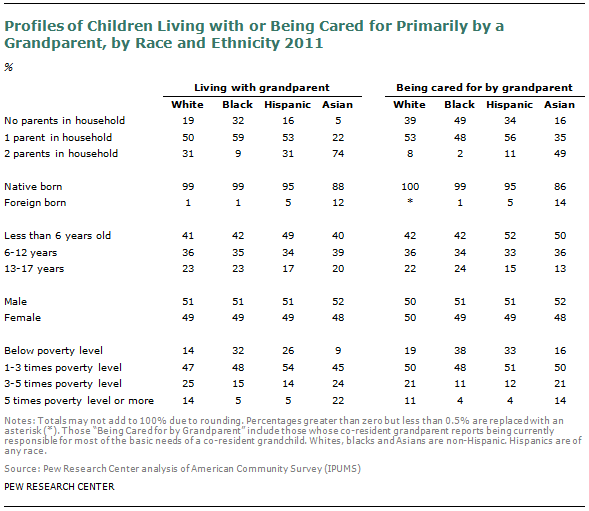
Nativity differences among children living with or being cared for primarily by a grandparent reflect the fact that a much larger share of Hispanic and Asian children in general are foreign born. Almost all black and white children either living with or being cared for primarily by a grandparent are native born; for Hispanic children, the share drops slightly to 95%. And some 88% of Asian children living with a grandparent are native born, as are 86% of Asian children being cared for primarily by a grandparent.
Among children living with their grandparents, Hispanics tend to be a bit younger than others—fully 49% are less than 6 years of age. Conversely, 17% are ages 13 to 17, compared with 23% of white and black children and 20% of Asian children. Among children being cared for primarily by grandparents, both Hispanics and Asians are relatively young—about half are less than 6, compared with 42% of both whites and blacks.
There are notable racial and ethnic differences in the prevalence of poverty among these children. And again, this is largely reflective of overall racial and ethnic differences in poverty. While 14% of white and 9% of Asian children who live with their grandparent are living below the poverty line, this number rises to 26% among Hispanic children and 32% among black children living with a grandparent. At the other end of the spectrum, just 5% of black and Hispanic children who live with a grandparent have household incomes at least five times the poverty level. This share rises to 14% for whites, and 22% for Asians.
The poverty profiles are similar among those children who are also being cared for primarily by a grandparent. While 38% of blacks and 33% of Hispanics are in households with annual incomes below the poverty line, these shares are 19% among whites and 16% among Asians. And while just 4% of black and Hispanic children who are being cared for primarily by grandparents have household incomes that are at least five times the poverty level, the shares rise to 11% for white children, and 14% for Asian children.




